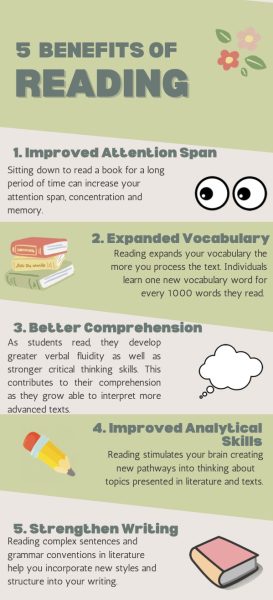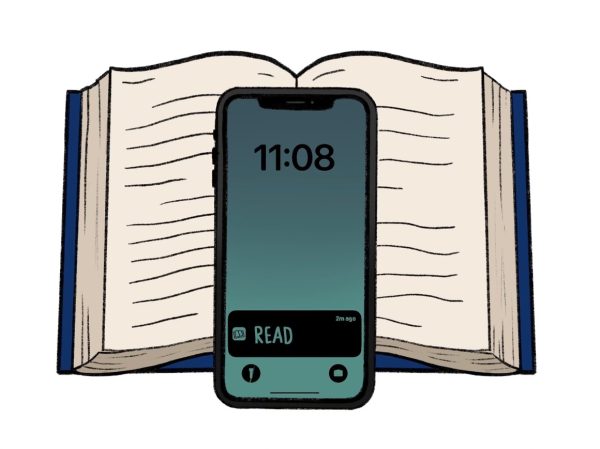“When I was in middle school, I used to read [around] 10 books a year. Now, I probably read two or three,” Lucy Tonderys, a junior and the treasurer of the Redwood Book Club said.
This adjustment Tonderys describes is the reality for many high schoolers across the country. As teenagers’ schedules become increasingly packed with the demands of school work and extracurriculars, there is often less time available to slow down and pick up a book to read for personal interest. In fact, according to a Bark survey, 36 percent of students at Redwood have not finished a non-school required book in a year or more. Redwood library specialist Kathleen Savastano noticed these changes and highlighted how increased use of technology may be a key factor.

“I think that young people have so many distractions, so [to] sit down and read a book, [requires] you to carve out time,” Savastano said.
This new dynamic of reading less and using technology more directly jeopardizes the comprehension and academic skills of students. According to a study by the Economic and Social Research Council in the United Kingdom, students in college who read in their spare time understand 26 percent more of the material in class than students who do not.
In Redwood’s Book Club, Tonderys aims to counteract the decline of reading by reigniting students’ interest in reading. To do this, the club uses strategies such as student-led discussions to increase attention spans and individuals’ understanding of written material.
“We just want to make people feel interested in reading again because it feels like [students] aren’t at the moment. We [choose]books that [usually] have movies to go along with [them], because [we] know that watching something can intrigue people,” Tonderys said.
As students grow more reluctant to pick up a book because of the distractions that technology poses, the extent of reading that takes place outside the classroom plummets. This is highlighted in a recent Bark survey. Students were asked about the main purpose for their reading with 32 percent responding that they read for class requirements, while 17 percent felt like they did not read enough to answer.
According to a 2018 survey by the American Psychological Association, a third of the 12th graders surveyed had failed to read a book by choice in the past year. This can be compared to the 1970s, when three times as many kids read for pleasure. The study found that the result of this decrease in reading can be tied to the emergence of technology in the early 2000s.
Avery Tucker, a junior, avid reader and Redwood Book Club member, has noticed these changes, as her daily life has been increasingly filled with more distractions, one being technology.
“Social media is especially prevalent among [high schoolers] and a lot of kids are spending more time on their phones [instead of] reading,” Tucker said.
This decline in reading all around campus has surprised Savastano as she came from an environment that reflected different dynamics.

“When I first came to work at Redwood in the fall of 2019, I was fairly disappointed that kids were not reading that much. I had worked at the middle school in Mill Valley for 10 years and middle school kids read more than the high school kids,” Savastano said.
While reading trends have declined over the past few years, the benefits that reading can bring remain powerful. Sitting down for only 30 minutes a day with a book can help individuals develop skills as a writer, including vocabulary and grammar mechanics. Tucker notices her English mechanics and cultural knowledge grow as she indulges in the world of reading.
“I think [reading] helps you learn grammar conventions and even though you don’t know them officially, you get fluent and it helps you learn new words,” Tucker said.
Not only does literature help strengthen one’s vocabulary and writing skills, but readers can also learn to broaden their cultural perspectives through the transportation into different worlds and viewpoints. According to K12 Reader, one thing that enables students to improve text structures and writing mechanics is reading a variety of genres to expand their vocabulary and transfer into their skills.
“I mean, knowledge is a big [benefit], [you] build a better vocabulary. [But reading also] opens your mind to different cultures. You may have never been to a country, but if you read a book that is set there, you get a better feel for it [and] you pick up a lot of trivia,” Savastano said.
Tonderys hopes that through Book Club, she can help high schoolers rediscover the passion for reading that they once carried in elementary or middle school.

“[One idea for getting high schoolers reading] is setting goals for yourself. When [we] were younger, [we] had reading logs, and those kept us on track of reading, so I think [it is] a good way to [hold yourself accountable],” Tonderys said.
Savastano agrees that holding yourself accountable to read is a great way to get back into it. One way to do this is through book clubs. This activity can provide the opportunity for spoken analysis of books and can further individuals’ passion and excitement for reading, especially as students move beyond requirements for school. While school-required reading can provide structure for conversation, book clubs are more community-oriented and drive students away from the notion that reading is a requirement, rather than something to find pleasure from.
“I think [book clubs] help in terms of people reading more as adults. When you’re in school, you get assigned reading, but as an adult, you have to have the habit [of reading]. If you join a book club, you adapt to that,” Savastano said.
As students read less amid the difficulties and stresses of high school, it is important to keep in mind the benefits that reading for pleasure can bring. Reading serves as a powerful tool for imagination and knowledge of the world, providing students with more information about different cultures and strengthening their academic skills, one page at a time.






